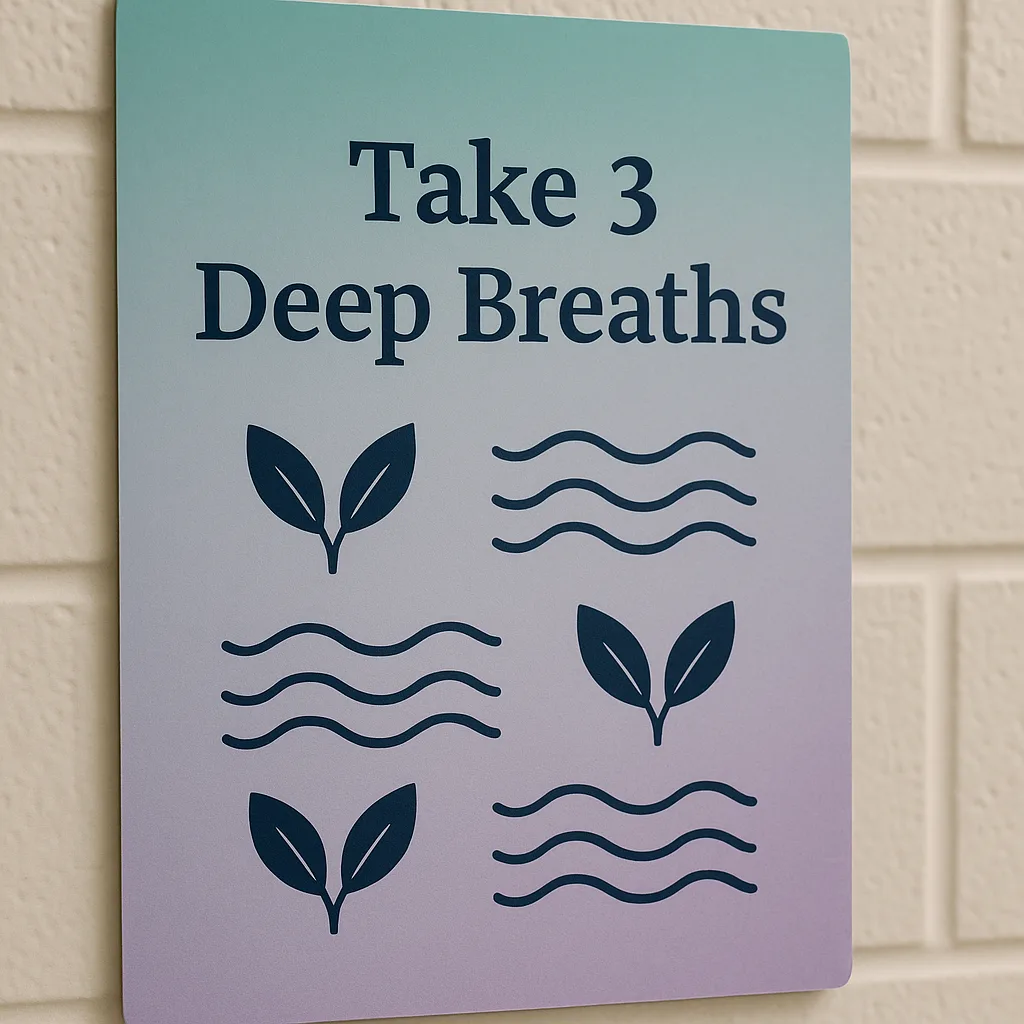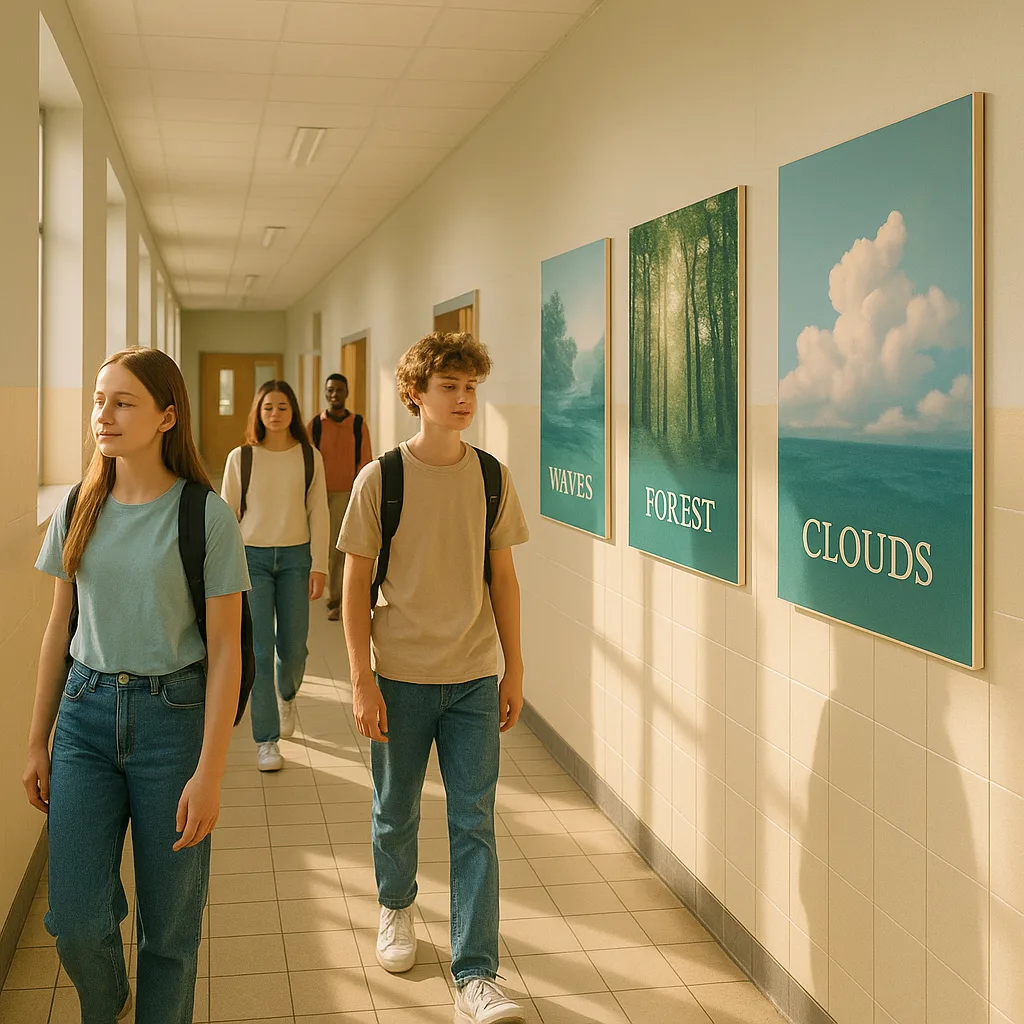Poster Maker Machine for Schools: Calm Transition Spaces
Understanding the Neuroscience of Visual Environments
Recent neuroscience research reveals fascinating connections between our visual environment and emotional regulation. When students encounter specific colors, patterns, and spatial arrangements, their brains respond with measurable changes in cortisol levels and neural activity patterns. Therefore, the posters and visual displays we create aren’t just decorative elements—they’re active participants in shaping student behavior and emotional states.
Studies from Stanford’s Clinical Psychology department demonstrate that exposure to certain color wavelengths can reduce stress hormones by up to 23% within minutes. For instance, soft blue-green hues (wavelengths between 480-520 nanometers) activate the parasympathetic nervous system, promoting calm and focus. Meanwhile, warm earth tones ground students in the present moment, reducing anxiety about upcoming transitions.
Pattern recognition also plays a crucial role in emotional regulation. Our brains are wired to find comfort in predictable, gentle patterns—think of how waves lapping on a shore or leaves rustling in wind naturally soothe us. By incorporating these organic patterns into transition space posters, we tap into evolutionary responses that signal safety and stability.

The Hidden Impact of Poster Maker Machine for Schools Transition Spaces
Environmental psychology teaches us that every visual element in a space communicates subconsciously with students. Traditional approaches often overlook how transition areas—hallways, doorways, and movement zones—shape student experiences throughout the day. However, with strategic poster placement and design, these spaces become powerful tools for emotional support.
Research published in the Journal of Educational Psychology indicates that students exposed to calming visual cues during transitions show:
– 40% reduction in disruptive behaviors
– Improved focus when entering new learning activities
– Enhanced emotional self-regulation skills
– Decreased anxiety levels during high-stress periods
The poster printer price becomes a worthwhile investment when we consider these profound impacts on daily classroom management and student well-being.
“Creating calm spaces isn’t about perfection—it’s about intention. Every poster you design with care sends a message to students that their emotional well-being matters.”
Practical Strategies for Calming Visual Design
Color Psychology
Use soft blues and greens to activate calming neural pathwaysImplementation Tips
Choose colors with wavelengths between 480-550nm for maximum calming effect. The Campus Pro 36 Poster Maker produces exceptional color accuracy for these therapeutic hues.Pattern Design
Incorporate organic, nature-inspired patterns for stress reductionResearch Insights
Studies show that fractal patterns found in nature reduce stress by 60%. Create posters featuring gentle waves, clouds, or botanical elements for transition areas.Spatial Flow
Guide movement with thoughtful poster placementStrategic Placement
Position calming posters at eye level along transition routes. Create visual “stepping stones” that naturally guide students while providing emotional anchors.Creating Your Calming Poster Collection
Let’s explore specific poster designs that leverage environmental psychology principles to support student transitions.
Morning Arrival Posters
Design morning transition posters with:
– Sunrise gradients in warm, gentle tones
– Affirmations in rounded, friendly fonts
– Nature scenes with soft focus effects
– Breathing exercise reminders
These visual cues help students shift from home to school mindset peacefully.
Transition Timer Displays
Create visual timers that:
– Use color gradients to show time passing
– Include calming imagery as backgrounds
– Feature gentle reminders about next activities
– Incorporate mindfulness prompts
The predictability reduces transition anxiety significantly.
Investment Considerations: Making the Case for Your School
Reduction in nurse visits for anxiety
Improvement in transition times
Teacher satisfaction increase
Students report feeling calmer
Understanding Poster Printer Price in Context
When administrators first consider the poster printer price, it’s natural to focus solely on the initial investment. However, understanding the comprehensive value requires looking at both immediate and long-term benefits. Traditional outsourcing costs for professional posters range from $25-$75 per poster, while in-house printing with quality machines like the Classroom Pro 24 Elite Package reduces costs to under $3 per poster.
Beyond financial savings, consider the therapeutic value. If calming transition posters prevent even one serious behavioral incident per month, the emotional and administrative savings are immeasurable. Furthermore, having immediate access to poster creation empowers teachers to respond dynamically to student needs, creating timely visual supports for emerging challenges.
Many schools utilize various funding sources to make this investment accessible, including wellness grants, SEL funding, and PTA support. The poster printer price becomes even more reasonable when shared across departments or grade levels.
Implementation Guide: Your First 30 Days
Week 1-2: Assessment and Planning
Observe current transition challenges:
• Document problem areas and times
• Survey students about stress points
• Identify highest-need locations
Design your first poster set:
• Choose calming color palettes
• Select appropriate imagery
• Create simple, clear messages
• Test designs with small groups
Week 3-4: Implementation and Adjustment
Strategic poster placement:
• Install during calm periods
• Introduce posters to students
• Explain the purpose simply
• Model using the visual cues
Monitor and refine:
• Observe student responses
• Gather feedback from staff
• Adjust placement as needed
• Create additional designs

